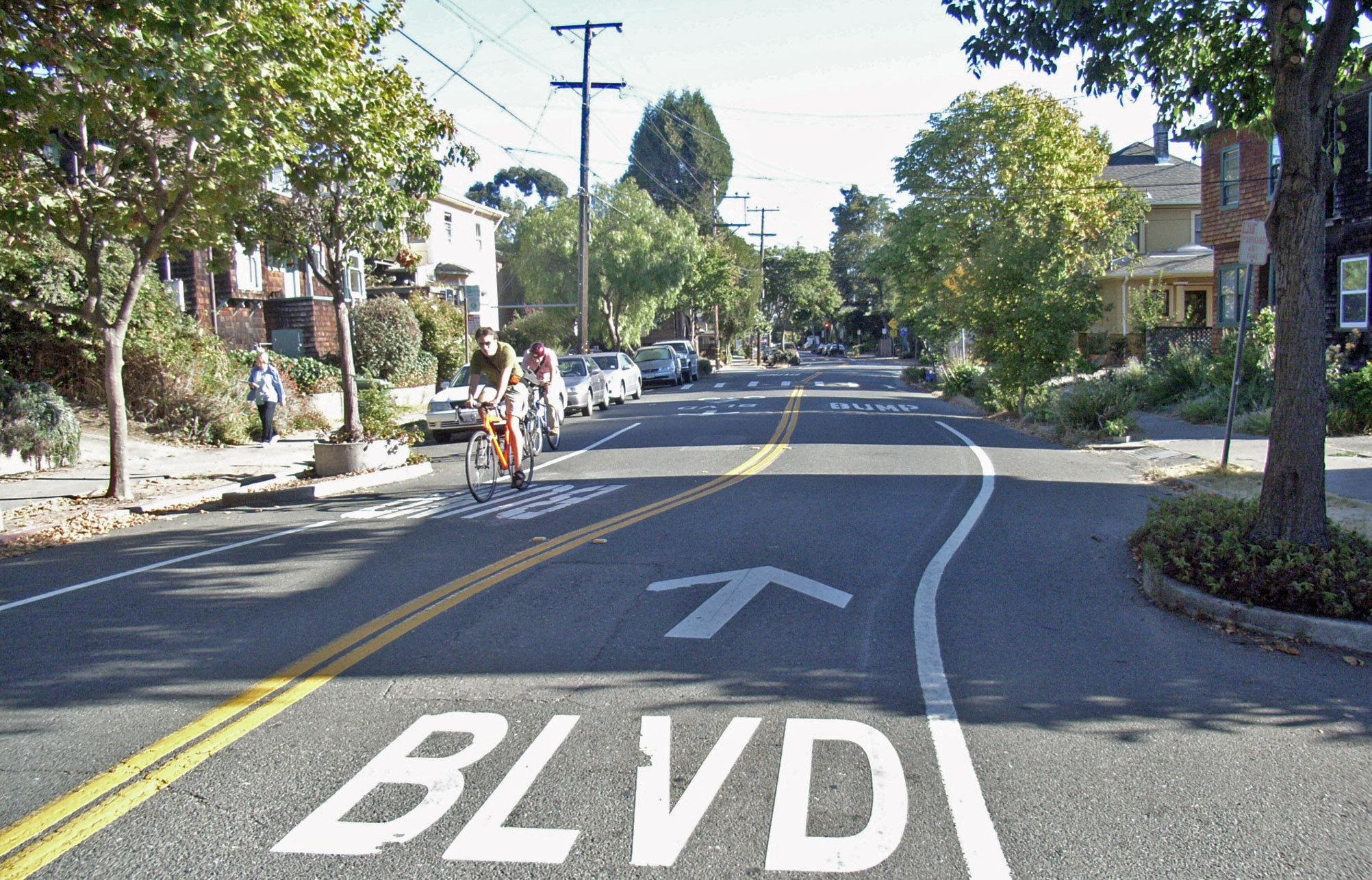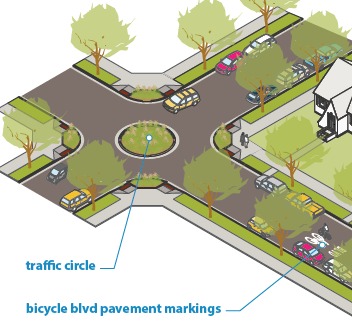
This post is part of a Street Design Standards series, and is the second of four street typlogies proposed.
Active Streets are similar to Local Streets, but with additional features to encourage and prioritize active transportation including biking, rolling, and walking. Well-planned Active Streets form a cohesive network of safe, convenient, and direct connections to local destinations and between neighborhoods. Low vehicle volumes and speeds are an essential characteristic of Active Streets, and the typology shares many facets of the bicycle boulevard or neighborhood greenway street types found in other jurisdictions.
Design Goals of an Active Street

- Low volumes and slow speeds of motor vehicles
- Safe, convenient, and comfortable for active travel modes
- Cohesive network and well connected to destinations
It is important to provide a safe, convenient, and comfortable experience for all ages and abilities on Active Streets as this increases usage, creating a positive feedback loop. Furthermore, a street on which the average motorist is willing to cycle or walk creates a viable alternative to driving, and is the most likely street type to displace short car trips. Motorists must still be accommodated by providing limited traffic access and on-street parking, but Active Streets prioritize the safety, convenience, and comfort for active transportation users first.
Low vehicle volumes and speed are the primary factor for achieving a successful Active Street network. Many design features can help accomplish this, the most common of which is the modal filter which diverts through-traffic onto bigger roads. While motorists are never prevented from entering an Active Street, the look and feel of the street and its entrances should clearly indicate that motorists are guests.
Finally, the network’s cohesive nature allows safe and comfortable travel between destinations across the city without leaving the network. This has less to do with street design and more to do with transportation planning, but is still important to keep in mind. Fortunately, Sacramento’s Neighborhood Connections draft plan contains many good things to say about the importance of planning a cohesive network.
Design Features of an Active Street

While painted or protected bicycle lanes may jump to mind as examples of bicycle infrastructure, they are not the only way to encourage and prioritize active transportation while reducing potential conflicts.
Modal filters (a.k.a. traffic diverters) are a key feature of Active Streets that are used to disincentivize vehicle presence without restricting through-traffic for active transportation users. Modal filters are already used extensively in and near Midtown, and have a proven track record for improving Midtown’s livability.
Yield Streets are extremely narrow bi-directional streets (typically 13-15 feet between parked cars), requiring opposing traffic to yield to each other to allow safe passage. This is among the most effective traffic calming treatments and also disincentives vehicle presence. This is an example where updating minimum lane widths to maximum lane widths allows the flexibility needed to design a narrower, safer street.
Curb Extensions extend the sidewalk into the street at critical locations such as crosswalks and intersections. This improves safety by reducing turning speeds and the amount of time pedestrians are vulnerable while crossing.
Chicanes are mid-block curb extensions that slow traffic by breaking up long, straight stretches of street.

Image: Payton Chung
Trees and shrubs visually narrow the street (if they are curb-tight), thereby slowing motor vehicle traffic and providing for a shaded, more comfortable active transportation experience.
Textured surfaces can physically and visually calm motor vehicle traffic.
Gateway Treatments are a combination of multiple traffic calming treatments used at entrances. Entrances into Active Streets from bigger streets/roads must use gateway treatments to slow traffic and clearly signal a transition into a slower street where motorists are guests.

Image: Minneapolis Bicycle Boulevard
Uncontrolled Intersections lack stop signs, yield signs, traffic lights, or any other traffic controls. When combined with mini traffic circles and other traffic calming measures, uncontrolled intersections can improve cyclist comfort and safety within a network of Active Streets.

Image: Minneapolis Bicycle Boulevard
Right-of-way over Local Streets: Traffic on Active Streets may even be prioritized at intersections with slower Local Streets to minimize the number of complete stops, improving comfort.
Precedent
- Berkeley Bicycle Boulevard
- Sacramento Neighborhood Connections
- Portland Neighborhood Greenway
- Minneapolis Greenways
- Boston Neighborways
- Dutch Fietstraat
- NACTO Bicycle Boulevard